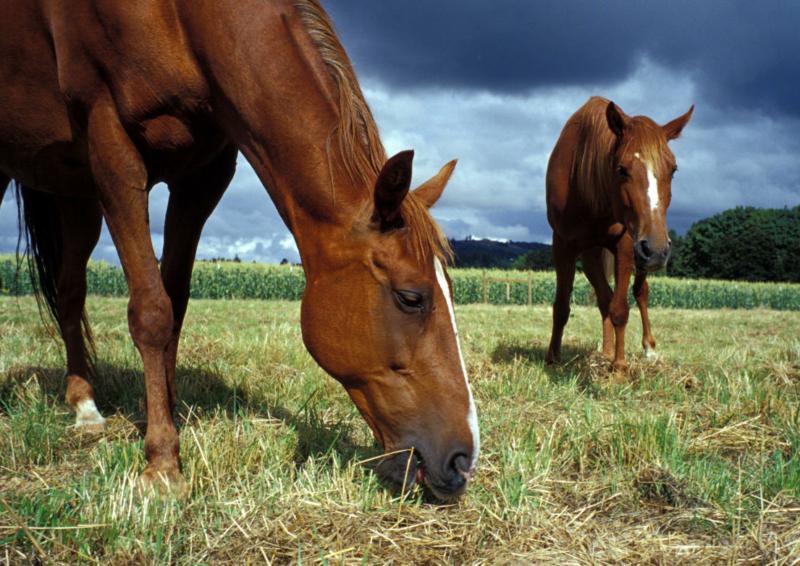
Agricultural News
Tips for Guarding Against Heat Stress in Horses
Fri, 17 May 2013 11:03:52 CDT

Oklahoma temperatures will be soaring upwards soon and that can be quite a shock for horses, especially given how Old Man Winter hung on until recent weeks.
"The sudden shift from cooler-than-normal temperatures to those associated with summer underscores the need for horse owners to monitor their animals closely," said Tommy Puffinbarger, Alfalfa County Extension director and agricultural educator. "Body heat is produced as a by-product in a horse's daily metabolic process, and regulating this heat build-up can be quite a stress on a horse's system."
During exercise, there is a significant increase in the amount of heat produced by working muscles. Heat production estimates can increase as much as 50 percent during periods of intense exercise as compared with heat production when the horse is at rest. In response, a horse increases its sweating rate, moves more blood to the capillaries under the skin and increases its rate of breathing in an effort to release this build-up of heat.
"Heat stress from exercise can result when the environmental temperature is high," Puffinbarger said. "Commonly observed signs of heat stress are profuse sweating, rapid breathing rate and rapid heart rate."
Furthermore, some horses are anhidrotic, meaning they have little or no ability to produce sweat. Since heat loss is mainly dependent on convection (wind) and evaporation (sweating), anhidrotic horses are prime candidates for heat stress.
"Although not all that common a condition, owners who suspect a horse to be anhidrotic should consult with their veterinarian, as diagnostic tests exist that can be conducted," said Dave Freeman, Oklahoma State University Cooperative Extension equine specialist.
Early stages of heat stress can advance into more critical symptoms associated with heat stroke. Symptoms include skin that is dry and hot, pulse and respiratory rates much higher than normal and unusually high rectal temperatures.
"Horses that exhibit these symptoms require immediate attention," Freeman said. "The owner should seek input from an equine veterinarian quickly."
Freeman advises the horse be moved to a shady area with fans or wind to provide ventilation. Cool water should be sprayed on the body and legs of the animal's body to help the evaporation process.
"In critical situations, the attending veterinarian may advise that ice packs be placed on legs and other areas that exhibit large veins surfaced on the horse," he said. "Veterinarians normally will give large amounts of fluid to the animal, and possibly give cold water enemas or drenches if the core temperature is extremely high."
Normally, a horse's rectal temperature is around 101 degrees Fahrenheit. The critical temperature, one that is characteristic of a life-threatening situation if maintained for any length of time, is around 104 degrees Fahrenheit.
The best recommendation is for equine owners to know how to identify heat stress in a horse before it progresses. Relieving the horse from exercise and cooling the animal's body by fans and shade will help to lower the stress and aid in recovery.
"Also, care must be taken that the horse doesn't become dehydrated during long bouts of exercise," Freeman said. "Large amounts of fluid can be lost through sweat. Generally, horses should be allowed to drink as frequently as they desire, even during periods of exercise, unless they are showing definite signs of heat stress."
Some recommendations suggest limiting free access to water when horses are extremely hot because of the chance of digestive upset. For these times, an attending veterinarian may recommend to riders that they offer small amounts of water to the horse in frequent intervals before, during and after exercise, rather than allowing the horse to self-regulate intake.
"Regardless of how quickly allowed, replacement of water loss is important so monitoring the animal's intake and level of dehydration is critical," Freeman said.
One simple test that can be used to determine marginal water loss in a horse is the pinch test. When a section of skin on the neck or shoulder is pinched, the skin recoil will be immediate in normally hydrated horses. Dehydration will delay skin recoil.
Finally, it is important not to overlook cool-down periods following exercise bouts, even when environmental temperatures are well within normal parameters.
"Large amounts of heat build in a horse during work," Puffinbarger said. "This heat must be released from the horse's body through respiration and sweat. The commonly used practice of walking a hot horse guards against placing it in an area void of air flow."
The length of cool-down procedures will depend on the amount of work, the environmental conditions and the individual horse. Puffinbarger and Freeman said horse owners who use these simple procedures and who know the signs of heat stress in horses can help prevent heat stroke in their animals.
By Donald Stotts, Communications Specialist, Oklahoma State University
WebReadyTM Powered by WireReady® NSI
Top Agricultural News
More Headlines...



















